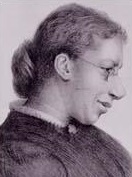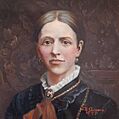Helen Blackburn facts for kids
Quick facts for kids
Helen Blackburn
|
|
|---|---|
 |
|
| Born | 25 May 1842 |
| Died | 11 January 1903 London
|
Helen Blackburn (born May 25, 1842 – died January 11, 1903) was an important person who fought for women's rights. She especially worked to improve how women were treated in jobs. Helen Blackburn was also an editor for a magazine called the Englishwoman's Review.
Contents
Her Life and Work
Helen Blackburn was born in Knightstown, County Kerry, Ireland. Her father, Bewicke Blackburn, was an engineer. Her mother was Isabella Lamb. In 1859, her family moved to London. There, she met women from the Langham Place Group. This group included Jessie Boucherett and Emily Faithfull. They were all working to improve women's lives.
Working with Jessie Boucherett
Helen Blackburn and Jessie Boucherett worked together on many projects. They both edited the Englishwoman's Review magazine. Helen was the editor from 1880 to 1890. Then, she was a joint editor with Jessie from 1890 to 1895.
In 1891, they started the Women's Employment Defence League. This group helped protect women's jobs. They fought against laws that made it harder for women to work. They also edited a book together in 1896. It was called The Condition of Working Women and the Factory Acts.
Fighting for Women's Vote
In 1872, Helen Blackburn joined the National Society for Women's Suffrage. This group wanted women to have the right to vote. She was a secretary for the group's main committee from 1874 to 1880. She also held similar jobs in other groups that supported women's rights.
Helen also liked to learn. In 1875, she took a class about Roman Law at University College London. Later, from 1886 to 1888, she took classes at University College, Bristol.
In the early 1890s, she helped Charlotte Carmichael Stopes. Charlotte was writing a book called British Freewomen: Their Historical Privilege. Helen gave her notes and even bought all the copies of the first edition in 1894. Helen retired in 1895 to take care of her father. But she later returned to her work for women's rights.
Collections and Projects
Helen Blackburn helped create two special collections. The first was an art collection in 1885. It showed pictures and artwork made by professional women. She wanted to show what women could achieve in their careers. She made sure it only included work from professionals, not hobbies. This collection was called the Loan Exhibition of Women's Industries. It included portraits of famous women like Florence Nightingale and Mary Carpenter. This collection was given to Bristol University, but sadly, it is now lost.
Her second collection was a group of books written by women. She gathered books from her own collection, from friends, and from second-hand shops. She even had special bookplates made. Two bookcases were also made for these books. These bookcases were decorated with paintings of Lydia Becker and Caroline Ashurst Biggs. These two women had led the Central Committee of the National Society for Women's Suffrage. These special bookcases were given to Girton College and are still there today.
In 1880, Helen was the secretary of the West of England Suffrage Society in Bristol. She helped organize a very large public event there.
Later Years and Legacy
Because she worked with the women's movement for so long, Helen wrote a history book. It was about the fight for women's right to vote in Victorian times. The book was called Women's suffrage: a record of the women's suffrage movement in the British Isles, with biographical sketches of Miss Becker. She finished it in 1902, just before she died.
Helen Blackburn passed away on January 11, 1903, in Westminster, London. She was 60 years old. She was buried at Brompton Cemetery. She left her important papers and the decorated book collection to Girton College, Cambridge. Her will also set up a fund. This fund would lend money to young women to help them get training.
In 1903, Helen worked with Nora Vynne to write a book called Women under the Factory Act. In this book, they criticized lawmakers. They felt that laws treated women as if they were not smart enough to make their own choices. Helen and Nora argued that women should be allowed to take risks in their jobs. Otherwise, they might always be seen as weak and unable to work. The book was known for being very accurate. However, some people thought it had a political goal. They believed it was arguing for "equality of men and women."
Remembering Helen Blackburn
Helen Blackburn is remembered for her work. Her name and picture are on the base of the statue of Millicent Fawcett in Parliament Square, London. This statue was revealed in 2018. It honors many women who supported women's right to vote.
Her Books
Here are some of the books Helen Blackburn wrote or helped to write:
- A Handbook for Women Engaged in Social and Political Work, 1881.
- The Condition of Working Women and the Factory Acts, edited with Jessie Boucherett, 1896.
- Women under the Factory Act, written with Nora Vynne, 1903.
- Women's suffrage: a record of the women's suffrage movement in the British Isles, with biographical sketches of Miss Becker, 1902.
Images for kids
See also
 In Spanish: Helen Blackburn para niños
In Spanish: Helen Blackburn para niños


